
Before and after retirement is an excellent time to prepare the house for what might come next in life—before any significant health issues appear. Choosing to Age in Place earlier in life using Universal Design techniques means a family can longer enjoy the home without obstruction. Their relatives, visitors, and children have peace of mind assured the aging loved ones or the chronically ill are safer living at home.
Everyone planning to remain in their existing home to Age in Place is looking for safety, security, familiarity, ease of use, and comfort. Homeowners and their families should immediately plan for their future housing needs and work from an Aging in Place design checklist. The current housing inventory does not offer the features needed for safety and accessibility in the numbers required to accommodate the growing demand creating a need for home modifications and a niche market. Savvy homeowners and their family have weighed the costs of institutional living compared to their home’s expenses. They also realize the difference in adhering to stringent rules in an institutional facility instead of independently and freely residing in their present home.

The truth is, with professional help, you can adapt almost any home environment to enable you and everyone else in the family to live within it safely to the fullest extent. Aging in place design is not age-related because disability can instantly strike any family member of any age. The need for increased home accessibility is the common thread in any situation. Universal Design or inclusive design is a design and building pathway making homes more accessible to all regardless of their age, mobility, or ability when appropriately used. The Universal Design process offers a seamless path for Aging in Place providing help for those with a sudden disability. It additionally addresses the requirements of special needs families or multigenerational living situations. The elements of Universal Design provide common sense solutions for diverse living conditions.
Regardless of size or ability, people are becoming more familiar with Universal Design and Aging in Place when considering a home remodeling project. Some people use these words interchangeably, but while they are similar in nature, they do differ because of the time they are performed. Both are specific design techniques used in making a home more comfortable and accessible for individuals of different abilities. Universal Design deals more with customized new dwellings and a proactive remodeling approach for people desiring to Age in Place prior to any health issues taking over their life. Comparatively, Aging in Place home modifications strictly involve the remodeling of existing homes to accommodate physical needs brought on by sudden health issues in a reactive manner. The costs for both processes represent a beneficial investment in your home for future needs as opposed to merely spending involving aesthetically pleasing remodeling projects.
As an Aging in Place Specialist and one of Austin's premier Aging in Place contractors, I came to realize existing homes typically contain cramped, twisting hallways with narrow doorways, bathrooms without adequate maneuvering space for decreased usability, kitchens without accessible storage and workspaces, and stepped home entries. These are all common home design flaws. Every one of these common household problematic areas falls short of any Aging in Place design features. Hence, the home building industry has always lacked inclusion for all homeowners with their ever-changing needs.

As a Certified Aging in Place Specialist CAPS(#1636580), I am confident my book, "Age in Place at Home", introduces you to a new way of thinking about your home's future. It acts a guide for solving diverse home needs for all people affected by varying physical conditions and aging. I decided to write this book due to many customer requests for a summation of suggestions to improve their home's accessibility, comfort, usefulness, and sustainability and, ideas they could share with others. The book is full of Aging in Place design guidelines gleaned from witnessing years of shortcomings in traditional homes. I based the information provided on countless past home walkthroughs and home assessments. Within my book, you can discover room-by-room the benefits of using the principles of Universal Design and how to incorporate them periodically throughout your living environment at your own pace. I furthermore guide you through a home, making suggestions for what will increase your and your family's future accessibility. You will notice the chapters involving the bathroom and kitchen are very extensive. They represent the most important rooms to consider when planning to Age in Place. The most utilized rooms in our homes must accommodate all diverse residents and visitors.
Would you please not allow your home to hold you or any of your loved ones captive within its walls. Learn how to enable your home to conform to you and the needs of your family. Please think ahead positively and proactively while preparing for the future. IT JUST MAKES GOOD SENSE.

According to the 2000 census, nearly 50 million people in the United States have some type of disability. Of this group, 6.8 million have a condition that makes it difficult to bathe, dress and get around the inside of their own homes. T-Square Company has the training and knowledge to help with disabilities because we are a Certified Aging in Place Specialist (CAPS).
#accessiblehomes
Tags:
ADA compliant kitchen cabinets,
ADA accessible,
barrier free access,
aging in place remodeling,
ADA remodeling,
aging in place remodels,
ADA kitchen cabinets,
handicap accessible bathrooms,
aging in place construction,
CAPS professional in Austin,
accessible home remodeling,
CAPS remodeling techniques,
disability home remodeling in Austin,
aging in place specialist,
aging in place services,
aging in place design,,
certified aging in place specialist,
handicap remodeling contractors in Austin,
handicap home modifications for disabled,
disability access bathrooms Austin,
universal design ideas,
Austin accessible home remodeling,
certified aging in place consultant in Austin,
aging in place specialist in Austin,
senior aging in place services,
home remodeling for disabled,
home accessibility help in Austin,
home remodeling for disabled in Austin Texas,
wheelchair accessible home remodeling in Austin,
universal design remodeling contractor,
principles of universal design,
disability contractor in Austin,
special needs contractor in Austin,
handicap accessible remodeling,
barrier free remodeling,
handicap accessible home modifications,
disability remodeling,
handicap bathroom remodel,
disability access contractor,
barrier free showers in Austin,
ADA vanity in Austin,
accessible bathroom remodel,
what is ada compliant,
accessible homes,
universal design contractor,
accessible housing,
Austin home remodeling for disabled,
modifying your home for a disabled child,
wheelchair accessible homes,
the basics of aging in place,
barrier free kitchens,
barrier free design,
Austin home accessibility solutions,
Age in Place at Home
Let's face it, accessible homes are needed by all of us at some time during our lives. This is true whether it's for ourselves, a family member, or a guest. The need for handicap remodeling is certainly not driven by age but is a result of life's experience. Any family living with disability among any of it's generations within the group can always benefit from additional accessibility. This will in turn increase safety and independence for all people involved as they go about life. Except under extreme situations, complete ADA-compliance normally isn't required for a remodel used to increase residential accessibility. The ADA rules are a great place to begin a design when dealing with a lack of home accessibility. However, any and all compliant items are a great help for everyone. The ADA specifications deal with explicit measurements, but these stringent rules do not apply to many people. Diverse body sizes and abilities are overlooked, and everyone is dealt with on average. More so, only if modifications involve government backed housing and funding are the ADA guidelines followed to the letter. In other words, the guidelines aren't a consideration when dealing with a single private family residence. So how did the ADA guidelines come about?
During the 1960's, the Americans with Disabilities Act (ADA) was signed into law, protecting the civil rights of those with disabilities. This law was merely a beginning, acknowledging a part of our population was dealing with disabilities. Although this law did not directly address disabilities per se, it served as a foundational piece of civil rights legislation. Disability advocates applied the language used in the Civil Rights Act for later legislation concerning civil rights for those with disabilities. Later on, the Americans with Disabilities Act, also known as ADA, as we know it today began. First implemented in 1990, it was our government’s first step toward addressing the needs of citizens living with disabilities. Yet as technology and our culture evolved, so did the challenges faced by disabled Americans. Accessibility became a hurdle not only in the physical world but also the vast digital realm of today. The law is constantly evolving while changing with the times; thereby making everyday life easier for individuals with unique needs.
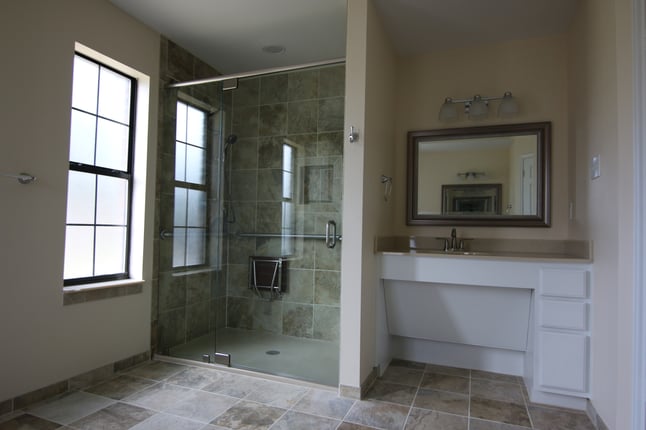
Disability is a complex phenomenon representing an interaction between one's physical impairments, the activities they need to perform, and the architectural barriers within the space in which this situation occurs. The terminology and jargon used for disabilities evolves regularly whereas, "handicapped" is no longer acceptable. It is no longer merely a description of intellectual or physical impairments. Each individual with similar impairments describes his or her limitations differently. The blind don't experience their world the same as a person with deafness and so on. Physically challenged has become the more socially accepted description of a person with an impairment, regardless of age. No matter how old you are, you should periodically evaluate your residence to determine whether it suits you not just for the present but the future. Your personal home assessments will be revised every time your living situation changes. Whether childproofing for a newborn, making a home more accessible following a sickness or unfortunate accident to someone in the family, or making a toilet area safer for an aging residing parent, there will be an immediate evolution to your primary domicile. These same life-span design features become more important if you believe you're past the age of wanting to move and are relishing the thought of aging in your own home, no matter what physical limitations you might later develop. This way of thinking has created a niche residential market known as Aging in Place. Solving Aging in Place issues will soon become the number one challenge concerning the present obsolete housing inventory in our country. Incorporating smart aging design concepts like a roll-in-shower into a home will attract a larger group of buyers when you decide to finally sell your home. Preparing for one of those highly likely events involving someone in your home needing room modifications for even a short time while recovering from surgery is surely a wise move.

In our daily lives, we all know what to do if the front door is no longer secure, if the kitchen sink backs up, or if the air conditioning suddenly goes out on a hot day. However, for those suddenly facing a catastrophic illness, life can suddenly be a scary and confusing place in which our existing homes are no longer a sanctuary but become a prison within the nightmare of limited accessibility. With the onset of a life-altering illness or catastrophic injury, knowing who to call to solve problems faced performing our usual daily tasks suddenly becomes very challenging.
Knowledgeable construction and design professionals are utilizing the CAPS training across the nation. CAPS stands for Certified Aging In Place Specialist. This designation is taught through the National Association of Home Builders in collaboration with AARP. CAPS connects responsible professionals with home owners who need these services on an ever-increasing basis. CAPS is a nationwide initiative and all active CAPS members can be found at nahb.org/CAPS. Look for the CAPS designation as a reliable way to identify professionals to modify your home or build a new forever home that is designed for a lifespan. CAPS graduates receive training about the technical/construction aspects and learn about the unique aspects of working with older Americans. They must take formal business training to maintain their credential through continuing education and subscribe to a Code of Ethics.
David L. Traut, CAPS the owner of T-Square Company in Austin, Texas is one of the select group of professionals to earn the Certified Aging In Place Specialist (CAPS) designation, identifying him as a home remodeler and builder with the skills and knowledge necessary to remodel or modify a home to meet the unique needs of the older population, disabled owners, or their visitors. T-Square Company offers a full compliment of Aging in Place services including bathroom modifications for elderly clients with special needs. Each design/build project will be customized to fit your personal needs increasing your accessibility. Call 512-444-0097 today to begin the accessible second chapter of your life while remaining safe and secure in your existing home. CAPS #1636580
As an answer to his clients requests over the years, David has recently published a book entitled "Age in Place at Home: Adapting the Home Environment for All Generations". The book reflects on thirty years of accessibility improvements and identifies why our traditional homes specifically lack this very basic need. It is available on Amazon and stands as a reference book for increasing home accessibility using the principles of Universal Design in every room of the home.
Tags:
ADA remodeling,
CAPS certified remodeling in Austin,
ADA compliance,
aging in place services,
elder construction,
certified aging in place specialist,
disability home modifications in Austin,
home modifications Austin, Texas,
wheelchair accessible showers in Austin,,
roll in showers in Austin,
home modifications for independent living Austin,
disability access bathrooms Austin,
disability remodeling in Austin,
universal design/build ideas,
Austin Accessibility Design,
Austin senior living solutions,
Austin accessible home remodeling,
Austin disability contractors for special needs,
Austin handicap bathroom contractor,
Austin home remodeling for disabled,
Disability Remodeling Services in Austin, Texas,
ADA Accessibility,
ADA Contractor/Austin, Texas,
Dripping Springs home accessibility solutions,
Dripping Springs special needs contractor,
Dripping Springs aging in place specialist,
Universal design construction in Austin,
Universal Design for Disabilities,
Barrier-free designs
How do you go about designing an Aging in Place bathroom? This is a common question weighing heavily on the minds of today's aging homeowners. Truly, Aging in Place is all about living independently for as long as possible within your existing home. It is also about being safe and healthy within your home which has had architectural barriers or dangerous areas removed using proven practical home modifications. Trained and certified CAPS professionals are working throughout the residential remodeling industry demonstrating how you can Age in Place with the greatest freedom of movement and maneuverability. Aging in place home design is a concept promoting independence and livability for all types of living environments no matter the age or level of abilities of the occupants. The principle is not entirely age related as recuperation periods from injuries or the progression of debilitating diseases like MS happen to anyone at any age.


Just imagine being an active 60-70 year old adult who is able to participate in a full array of activities. This person may continue to work well beyond retirement age, enjoy sports, and travel wherever he or she desires. Then imagine how this same person might react to recovering over a six to eight week period while recuperating from a hip or knee replacement. The inability to move from the bedroom to the bathroom or kitchen without the use of a cane, walker, or wheelchair can be psychologically devastating. Or imagine a person whose hands are now disfigured from the crippling effects of arthritis and they have lost the ability to grasp objects. Just turning on a sink faucet or opening drawers can seem insurmountable to a person with such disabilities. The homeowner has become a prisoner within their own realized inaccessible home in one way or another. This scenario can be avoided by proactive bathroom designs.
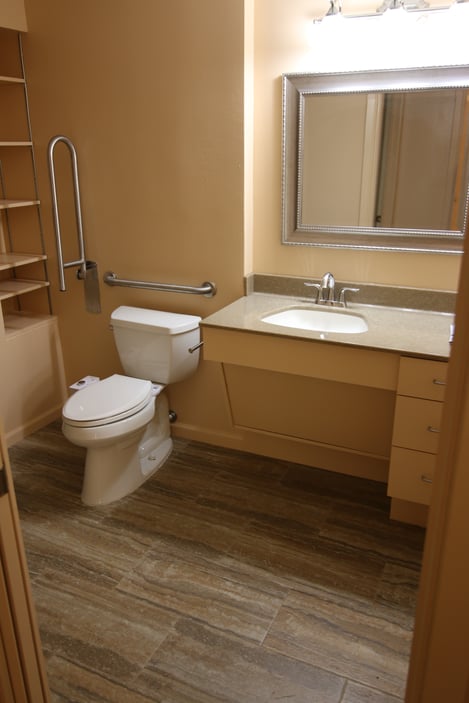

The physical challenges brought about by narrow hallways and doorways or high thresholds at the home's main entrance or shower area can create an impasse as they now have become physical barriers within the home. Not only has the ability to step over these barriers diminished but standing up from being seated on a low toilet seat has become almost impossible. Imagine the psychological impact of this limited environment on an individual who previously was accustomed to being fit, useful, and independent.
To accommodate the prospect of such physical challenges, dramatic changes to one's home may be necessary in order to Age in Place. Effective home adaptations and modifications can make any home safer and more manageable. Making important design decisions early in our lives can minimize the physical barriers and restrictions in one's home and secure access to the most essential areas like the kitchen and bathroom. This forethought will insure the dignity and independence for the homeowner in the event their mobility becomes restricted.
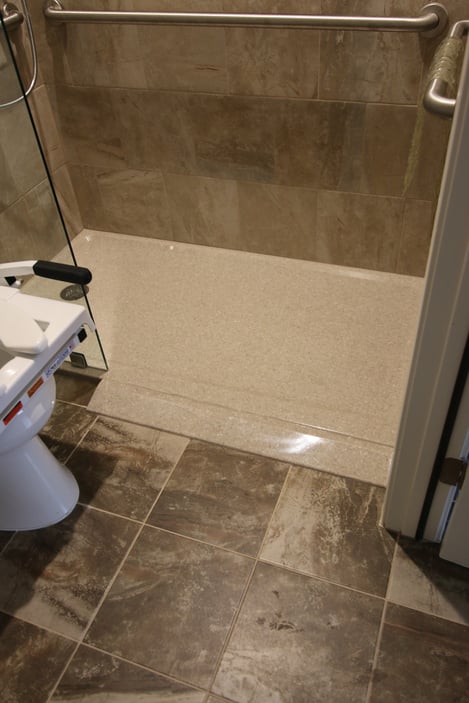
Universally, the Aging in Place bathroom is a little more spacious than in a traditional home with a five-foot turning radius observed. The new bathroom design is safer by reducing the potential for falls. In fact, there are many benefits to using Universal Design techniques, including potential use by aging family members, added resale value appealing to multiple generations, and the fact that you'll be creating a space that can be used by anyone who visits your home, regardless of their size or range of abilities. Bathrooms can be both functional and attractive when planned using elements of Universal Design like cabinetry that allows someone to sit at a barrier free bathroom sink. Either wrist handles or levers control all the faucets throughout the bathroom. Incorporate simple Universal Design updates for aging in place home modifications and handicap bathroom accessibility. Add secure ADA-compliant grab bars or handrails mounted on wooden blocking throughout the room around showers and accessible toilets, install adequate glare-free lighting in the shower and over work areas to prevent dark spots, perform a custom tub to shower conversion, add a seat within the curb-less roll in shower, provide recessed shelving within the shower to reduce floor clutter and tripping hazards, install a taller comfort-height toilet with a bidet attachment, lower upper cabinets and countertops or provide multiple layers for greater adaptability, add non-slip flooring, expand traffic ways, and widen entry doors. You might also consider lowering light switches and other electrical controls and installing easier to use door levers. Many considerations should be taken into account to provide safety and independence. You should try to provide a clear barrier free path or accessible route to this most visited area of your home as recommended by the ADA. Don't be afraid to spread the room out, because if the new design works well for wheelchairs, it works for everyone. Well planned accessible Aging in Place bathrooms lift the spirits and enhance dignity. They have the ability to transform our relationships with our bodies and our homes.

The National Association of Home Builders, in partnership with the AARP and Home Innovation Research Labs, created the CAPS program, which includes training and education on the technical, business management and customer service skills essential to compete in the fastest growing segment of the residential remodeling industry--home modifications for aging in place. David L. Traut, CAPS owner and President of T-Square Company in Austin, Texas as a handicap remodeling contractor is one of the select group of professionals nationwide to earn the Certified Aging-In-Place Specialist (CAPS) designation, identifying him as a home remodeler and builder with the skills, training, and knowledge necessary to design and remodel or modify a home to meet the unique needs of the older population, disabled owners, or their visitors.
By the way, David has recently published a book entitled "Age in Place at Home: Adapting the Home Environment for All Generations". It is available on Amazon and stands as a reference book for increasing home accessibility through Universal Design.
For additional information about the CAPS program, visit nahb.org/CAPS. For more information about T-Square Company, visit www.tsquareco.com or call 512-444-0097.
Tags:
ADA compliant kitchen cabinets,
aging in place home modifications,
aging in place home improvements in Austin,
aging in place construction,
accessibility home remodeling in Austin,
CAPS professional in Austin,
accessible home remodeling,
aging in place specialist,
aging in place services,
Austin elder construction,
bathroom accessibility remodels in Austin,
ADA bathroom Austin, Texas,
roll in showers,
roll in showers in Austin,
walk in shower designs Austin,
home modifications for independent living Austin,
disability access bathrooms Austin,
Austin Handicap Remodeling,
universal design ideas,
Austin accessible home remodeling,
certified aging in place consultant in Austin,
aging in place specialist in Austin,
aging in place design in Austin,
senior aging in place services,
age in place home design,
home accessibility help in Austin,
home access,
barrier free home design,
Age in Place at Home,
home modifications for aging in place,
barrier free bathroom layout

Everyone planning to remain in their home to Age in Place is looking for safety, security, ease of use, and comfort. Homeowners and families must plan for future housing needs. The current housing inventory does not offer the features needed for safety and accessibility in the numbers required to accommodate the growing demand. They have weighed the costs of institutional living compared to their home’s expenses. They also realize the difference in adhering to stringent rules in a facility instead of independently and freely residing in their present home.
Before and after retirement is an excellent time to prepare the house for what comes next in life—before any significant health issues appear. Choosing to Age in Place earlier in life using Universal Design techniques means a family can longer enjoy the home without obstruction. Their relatives, visitors, and children have peace of mind assured the aging loved ones or the chronically ill are safer living at home.
The truth is, with professional help, you can adapt almost any home environment to enable you and everyone else in the family to live within it to the fullest extent safely. The process is not age-related. Disability can strike any family member at any age. The need for greater home accessibilty is the common thread. Universal Design or inclusive design is a design and building pathway that makes homes more accessible to all regardless of their age, mobility, or ability when appropriately used. The design process offers a seamless path for Aging in Place. It addresses the requirements of special needs families or multigenerational situations. Solutions for diverse living conditions are now becoming a possibility.
Regardless of size or ability, people are becoming more familiar with Universal Design and Aging in Place if considering a home remodeling project. Some people use these words interchangeably, but while they are similar, they do differ. Both are specific design techniques used in making a home more comfortable and accessible for individuals of different abilities. Universal Design deals more with customized new dwellings and a proactive remodeling approach for people wanting to Age in Place before any health issues arise. Aging in Place strictly involves remodeling existing homes to accommodate physical needs brought on by sudden health issues in a reactive manner. The costs for both processes represent a beneficial investment in your home for future needs as opposed to merely spending involving aesthetically pleasing remodeling projects.
I came to realize over my building career that including cramped twisting hallways with narrow doorways, bathrooms lacking maneuvering space and usability, kitchens without accessible storage and workspaces, and stepped home entries were repeating home design flaws. The home building industry has always lacked inclusion for all homeowners with their ever-changing needs.

As a Certified Aging in Place (CAPS) professional (#1636580), I am confident this book, which will hopefully be available toward the end of 2022, will introduce you to a new way of thinking about your home's future. It offers a guide for solving diverse home needs for all people affected by varying physical conditions and aging. I decided to write this book due to many customer requests for a summation of suggestions to improve their home's accessibility, comfort, usefulness, and sustainability and, ideas they could share with others. I based the information provided on countless past walkthroughs and home assessments. Inside, you can discover room by room the benefits of using the principles of Universal Design and how to incorporate them periodically throughout your living environment at your own pace. I guide you through a home, making suggestions for what will increase your and your family's future accessibility. You will notice the chapters involving the bathroom and kitchen are pretty extensive. They represent the most important rooms to consider when planning to Age in Place. The most utilized rooms in our homes must accommodate all diverse residents and visitors.
Would you please not allow your home to hold you or your loved ones captive within its walls and enable your home to conform to you and the needs of your family. Please think ahead positively and proactively while preparing for the future. IT JUST MAKES GOOD SENSE.

#accessiblehomes
Tags:
ADA compliant kitchen cabinets,
ADA accessible,
barrier free access,
aging in place remodeling,
ADA remodeling,
aging in place remodels,
ADA kitchen cabinets,
handicap accessible bathrooms,
aging in place construction,
CAPS professional in Austin,
accessible home remodeling,
CAPS remodeling techniques,
disability home remodeling in Austin,
aging in place specialist,
aging in place services,
aging in place design,,
certified aging in place specialist,
handicap remodeling contractors in Austin,
handicap home modifications for disabled,
disability access bathrooms Austin,
universal design ideas,
Austin accessible home remodeling,
certified aging in place consultant in Austin,
aging in place specialist in Austin,
senior aging in place services,
home remodeling for disabled,
home accessibility help in Austin,
home remodeling for disabled in Austin Texas,
wheelchair accessible home remodeling in Austin,
universal design remodeling contractor,
principles of universal design,
disability contractor in Austin,
special needs contractor in Austin,
handicap accessible remodeling,
barrier free remodeling,
handicap accessible home modifications,
disability remodeling,
handicap bathroom remodel,
disability access contractor,
barrier free showers in Austin,
ADA vanity in Austin,
accessible bathroom remodel,
what is ada compliant,
accessible homes,
universal design contractor,
accessible housing,
Austin home remodeling for disabled,
modifying your home for a disabled child,
wheelchair accessible homes,
the basics of aging in place,
barrier free kitchens,
barrier free design,
Austin home accessibility solutions,
Age in Place at Home
As a universal design/build construction company located in Austin, Texas, T-Square Company realizes that building for your future changing needs is a very valuable consideration concerning all your periodic remodeling projects. We always design for the future for our clients, regardless of their age or abilities. This thought process is especially true when designing a bathroom upgrade. Being a nationally CAPS certified remodeler, we are very aware your personal needs can change in the blink of an eye. The daily tasks of getting into the bathroom, bathing, showering, using the toilet, or brushing your teeth can become almost impossible without assistance if you don't address your bathroom's inaccessibility in a proactive manner. Any revisions must be completed before you absolutely need the help. Design shortcomings become ever so noticeable if you have an accident and are recovering at home or a debilitating disease sets in. Most all problems caused by architectural barriers will be eliminated with a handicap accessible bathroom remodel.
We are certain that avoiding emergency remodeling while incorporating Universal Design techniques into your home whenever possible is a great way of enhancing your health, independence, and safety. This practice also provides a better overall quality of life. The sooner the main inaccessible areas in your home are addressed, the longer you and your family have to enjoy them. For those desiring to Age in Place, as in safely living in your own home for as long as possible, gradually incorporating the principles of Universal Design into all remodeling projects provides a seamless gateway for successful aging. So, what are the main concerns when designing a bathroom for the future?
Getting Into The Bathroom
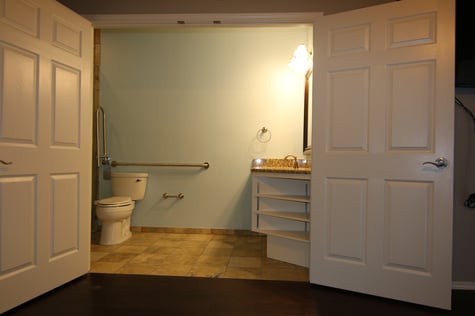
When possible, you should always install a 36-inch wide door into your bathroom allowing all mobility devices to enter without obstruction. Sometimes it's easier when walls cannot be altered or removed to make a large double door entry into the bathroom. Replacing the original twenty-four to twenty-eight-inch wide door offers maximum accessibility for anyone. This universal design element provides clear approaches toward all bathroom fixtures from an adjoining room. Additionally, an unobstructed 60-inch wheelchair turning radius is shared by the bathroom and adjacent room.
An Accessible Shower
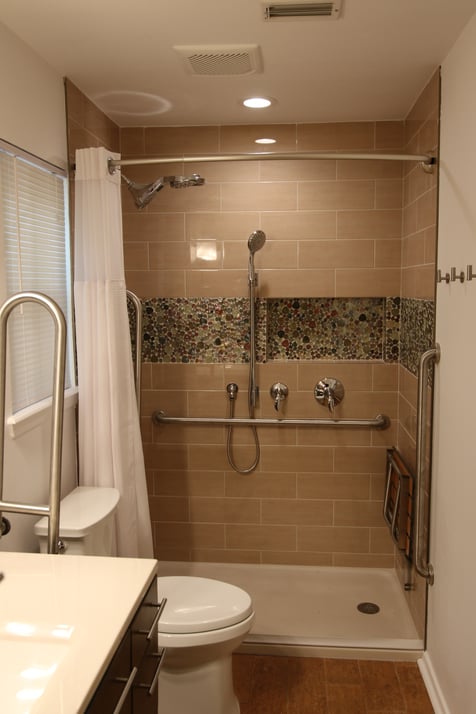
A safe, low-profile (1 1/2" tall) accessible shower with roll-in capability from an add-on ramp suits the needs of most diverse homeowners. Even if you don't require the grab bars during a particular phase of your life, installing adequate blocking before the tile is installed provides a universal path for your future needs once the bars are required. Take note, the grab bars must be able to withstand a shear force of 300 pounds. Their purpose is to provide support and stability when you need it most. Clutter within the shower and especially on the shower floor is a safety hazard. Recessed shampoo niches keep shampoo bottles and other items off the floor. Additionally, folding shower seats are far safer than free-standing models that are rarely ever in the right place. They save space when folded while not in use and never interrupt the use of a shower chair. It is a common misconception that shower controls must be mounted on one wall underneath the fixed shower head. Shower valves can be installed anywhere they are most convenient for the user, especially if a caretaker is involved. A recessed shower can light above the shower decreases shadows and further increases safety.
Using The Toilet
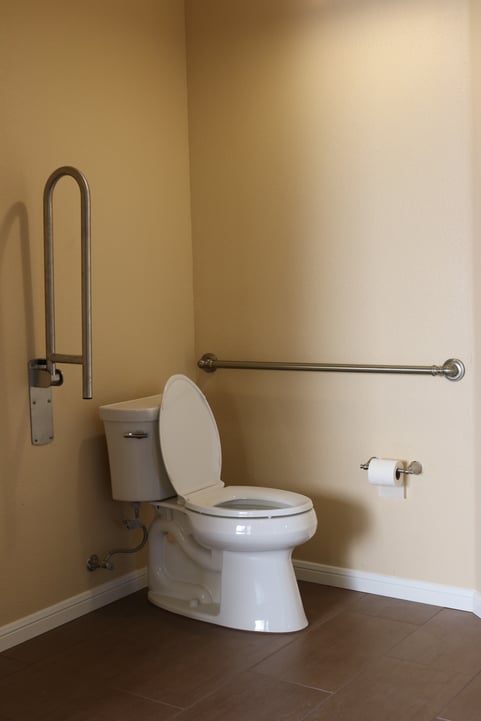
When a toilet exists in a confining room or space, there is no easy way of approaching it if you have mobility problems and especially if you are using any kind of mobility device. After all, safety is the predominant concern when using the toilet. Remove all restricting walls and narrow doors so everyone can freely approach and use the toilet. Once again, grab bars increase safety when they are required and must be adequately prepared for installation. Another problem with toilets involves those that are too short requiring deep knee bends for using them. A higher comfort height toilet offers significant help with this problem. Be sure the flush handle is toward the open side of the bathroom.
Brushing Your Teeth
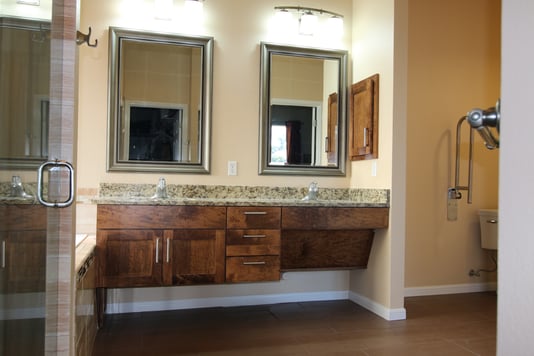
Offering adaptability in a vanity is a universal design aspect. Everyone has equal access while standing or using a wheelchair--if only for a short time during recoveries. More adaptability is offered using multiple height countertops. Lever faucets are easier for everyone to operate, even for those users with arthritis. Motion-sensor faucets create washing areas that are completely hand-free.
When you are ready to take the next steps toward your accessible future, contact T-Square Company in Austin, Texas. We can show you how to address your personal needs using our more than thirty years of knowledge and design/build accessibility experience. We guarantee to keep you safer in your existing home longer and out of dangerous and uncaring institutions using our proven design methods. We offer all handicap accessible home renovations or additions--especially accessible bathrooms.
David L. Traut, CAPS #1636580
Tags:
aging in place remodeling,
custom walk in showers,
certified aging in place specialist,
ADA bathroom Austin, Texas,
disability access bathrooms Austin,
Austin Handicap Remodeling,
universal design ideas,
universal design building for a lifetime,
home accessibility help in Austin,
universal design remodeling contractor,
7 principles of universal design,
applying principles of universal design in Austin,
handicap accessible remodeling,
barrier free remodeling,
disability remodeling,
handicap bathroom remodel,
ADA compliant wheelchair accessible showers,
disability access contractor,
veterans home accessibility help in Austin, Texas,
barrier free showers in Austin,
accessible bathroom design specifications,
ADA vanity in Austin,
accessible toilets,
what is an ADA compliant bathroom,
universal design/build contractor,
universal design vs. aging in place,
home accessibility,
accessible design,
why universal design,
what is aging in place,
accessibility home modifications,
handicap bathroom vanity,
handicap accessible floor plans,
maneuvering in and around the accessible home,
future home building using universal design,
universal design home additions
A Universal Design approach to kitchen conception takes into account people’s varying degrees of ability and disability rather than someone is either fully-functional or disabled. The diversity among the users of the kitchen includes size, age and agility. The kitchen represents the family hub, and for the designated cook of the day, it is where many hours are spent caring for the family. A Universally Designed kitchen supports the diversity of all cooks, users, and helpers. With the additional cooks like granny or the kids, the kitchen no longer adequately accommodates everyone’s participation and changes need to be made. This is especially noticeable once families decide to help each other and become multi-generational. Enlarged work spaces, larger passing areas, accessible work surfaces, storage within universal reach distances, accessible appliances, and flexible and layered lighting are a few of the inclusive changes for the kitchen. A cohesive blend of universal functionality for the abled and disabled with conventional convenience aspects for other family members is the goal guaranteeing a successful and accessible Universal Design kitchen for any home.

Homes with wheelchair accessible kitchens representing a by-product of Universal Design are a predictable necessity for the ever aging population. With the right layout, it is possible to make a home for maintaining the quality of life of the homeowners with disabilities while helping them live a more healthy, safe, and independent life. Kitchens with architectural barrier free layouts are more functional for everyone involved especially when mobility devices are required. Universal Design techniques give everyone a chance for equal independence. These very basic techniques provide adaptations or specialized designs regardless of age, ability, or situation.
In Universal Design kitchens, the work areas containing the sink and cook top have the capability of moving up and down with the touch of a button further accommodating the seated user or a helpful child. Cleaning is easier because of the adjustable height work and storage areas. When planning a Universal Design kitchen for anyone, every aspect of the space is considered from the cabinet height to the accessibility of appliances, to the space between cabinets and walls or islands. The principles of Universal Design call for the space to be functional and accessible for everyone in the household. This includes older homeowners with mobility or sight issues, as well as younger members of the family.

Layout and flow is especially considered when planning a Universal Design kitchen space. To promote functionality for all occupants, it is vital to consider every aspect of the design including doors, traffic patterns, and workstations. The universally designed accessible kitchen is one of usability. People need roll under capability at the sink and at least one food prep area if nowhere else. A clear floor space of 30 x 48 inches is provided in front of each accessible appliance and these areas of approach can overlap especially at the clear 5 foot turning radius. Raised dishwashers offer easier access to dishes and lowered microwaves and other appliances solve other reach distance problems making it easier to live with a disability.

Tags:
kitchen makeovers,
ADA accessible,
accessible routes,
barrier free access,
aging in place home modifications,
wheelchair accessible baths and kitchens,
handicap home modifications,
accessible home remodeling,
aging in place specialist,
disability home modifications in Austin,
kitchen cabinets Austin,
handicap home modifications for disabled,
ADA remodeling Austin, Texas,
accessibility designs Austin Texas,
kitchen cabinet remodel Austin, Texas,
Austin kitchen cabinets,
disability access bathrooms Austin,
disability remodeling in Austin,
universal design/build,
universal design ideas,
universal design/build ideas,
Austin accessible home remodeling,
universal design building for a lifetime,
home accessibility help in Austin,
wheelchair accessible home remodeling in Austin,
kitchen remodel near me,
kitchen remodeling company in Austin Texas,
universal design remodeling contractor,
universal design principles,
universal principles of design,
applying principles of universal design in Austin,
accessible home remodeling for disabilities,
home access,
accessible homes,
home access in Austin,
universal design techniques,
accessibility home modifications,
wheelchair accessible homes,
universal home design in Austin,
universal kitchen design,
wheelchair accessible kitchens,
universal design kitchen,
barrier free kitchens,
disability access kitchens
Making your home accessible for a child with special needs can be costly; but, it will also give your entire family a feeling of security and freedom if done correctly. It is estimated that 5.4 percent of children five to seven years old are disabled representing a considerably large portion of the population. For those children, having a home they can feel comfortable in is very important as they mature. Modifying your home for a child with a disability can be accomplished using Universal Design techniques. This concept will also benefit everyone within the family. When your child has a disability, whether from birth or following an accident, you must evolve quickly from being only a parent into a caretaker. It suddenly becomes your job not only to nurture your child but to identify his or her basic abilities and needs so your child can flourish in their world. Sometimes this is nearly impossible to do within a traditional home design. Since each type of disability is different; then each disability will require it's own special modifications to the house. Note that no one single type of disability is experienced the same by everyone because everybody is unique and has special needs. Specific modifications for wheelchair accessibility, visual impairments, sensory concerns, autism, or the use of special medical equipment along with any other of the child's special needs must be considered if the overall design is to be effective for the child. Generally, if a design works well for the disabled, it works equally well for everyone. With Universal Design thoughtful aesthetics and usability are harmonious.
There are seven criteria which must be met to be considered a Universal Design no matter which area of the home you are referring to. Any design must be equally useful to everyone, have flexibility in it's usefulness, be simple and intuitive, be perceived by everyone, have a tolerance for error, require little physical effort, and it must maintain an adequate area for approach and use. Any complexity or discriminating attribute to a design will doom it in terms of being considered universal in nature.

Neither the Universal Design or Inclusive Design concept is age driven nor is the aging in place issue. Universal Design addresses the design of all homes both new and existing while Aging In Place deals mostly with the built environment. Universal design/build addresses not only the problems all of today's homeowners face but the professional skills involved in design, building, remodeling, and all social and health services. This new evolving concept in home remodeling is catching on nation wide and has been for several years as a sign of the times. Universal design techniques used in building makes a home more accessible to all regardless of their mobility, age, or adaptive abilities. The multi-generational appeal of Universal Design is appealing to any homeowner, their children, or their parents. An evolution of new products used for disability home modifications is making those homes more accessible and has finally come about in the remodeling industry. These new advances in accessible home remodeling in Austin not only keep the living environments safer but will not compromise the home's aesthetics.
Wheelchair Accessible Bathroom
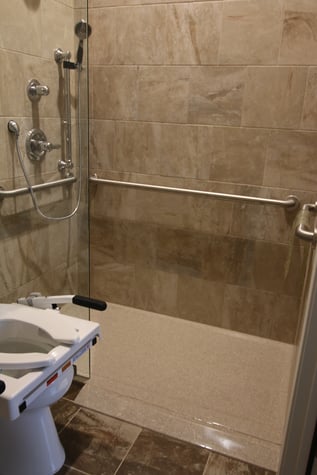
Universal Design doesn't strictly deal with accessibility and does not implement precise ADA standards but it does offer flexibility to add accessories now and later to those planning ahead or to the end user of a dwelling. It also provides for a wide range of human performance characteristics for the way people use spaces within their homes including well integrated usability features. These adaptations have a broad market appeal to everyone for achieving ease of use, safety, and convenience accommodating a certain reality. That reality is that all people exist along a continuum of human performance as per their personal traits and characteristics regardless of their age. A universal approach to design takes into account that everyone has varying degrees of ability and disability rather than someone is either fully-functional or disabled. A Universal Design is appealing to all users. It is very important to consider the safety of each room, as well as the exterior of the house and common spaces. Consider your child’s unique needs and how you can make your house safer for them. Whether your child recently acquired a disability or you have moved into a house that needs modifications for increased accessibility, your home must be assessed by a qualified CAPS design/build remodeler. They will be able to correlate the changes to the home environment with the needs of your disabled child.
Fortunately, to answer the demand for Universal Design, manufacturers continue to develop products for the home that help make the user’s experience safer and more comfortable. To answer the increasing demand for universal design, home appliance and plumbing manufacturers continue to develop products for the home that help make the user’s experience safer and more comfortable without sacrificing beauty.
The main focus of any home modifications done for a disabled child must make them feel more comfortable and be able to maneuver through and use the home more safely. It must present a safe place where he or she will be able to develop the life skills they need in their daily environment rather than just focusing on treatment regimens. Sometimes the living environment must be changed to make a significant impact on the child's life so they are able to feel safe and free to be themselves. Whatever is needed in the way of home modifications to create a safe and comfortable environment for your child is available through the registered and certified CAPS program practitioners. CAPS stands for Certified Aging In Place Specialist. This national designation is taught through the National Association of Home Builders in collaboration with AARP. CAPS connects responsible professionals with home owners who need these services on an ever increasing basis and is not age related. CAPS is a nationwide initiative and all active CAPS members can be found at nahb.org/CAPSdirectory.

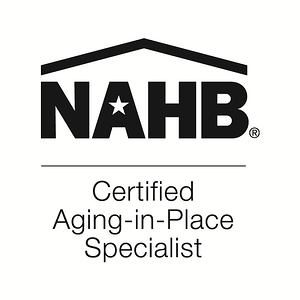
Universal Design does not equate to aging in place and accessibility design even though they both are concerned with ergonomics and human function issues. The ADA guidelines for accessibility were created as a means to help those people with extreme disabilities within our society who represent a narrow but specific sample of the masses. It provides a great cross section with average guidelines for people and their surroundings. A Universal Design approach broadly takes into account moderate impairments or disabilities, temporary health conditions, and the varying abilities of anyone within a home regardless of their age or size. In other words, an ADA accessible home would be designed for the one person with the disability whereas a Universal Design home is designed for everyone. Each situation should be assessed separately and the designer must take into account the parameters of the space, budget, and client priorities. If all of these needs are met, the result can be beautiful, efficient spaces that improve the independence, safety, and convenience of all household members with particular attention toward the needs of the disabled child.
.

David L. Traut, CAPS owner of T-Square Company in Austin, Texas as a handicap remodeling contractor is one of the select group of professionals nationwide to earn the Certified Aging In Place Specialist (CAPS) designation, identifying him as a home remodeler and builder with the skills, training, and knowledge necessary to design and remodel or modify a home to meet the unique needs of the older population, disabled owners or children, or their visitors. For more information about T-Square Company, visit www.tsquareco.com or call 512-444-0097.
We offer complete Aging In Place Services and designs and we are just a phone call away!
Tags:
aging in place construction,
custom tub to shower conversions,
accessibility home remodeling in Austin,
disability home remodeling in Austin,
certified aging in place specialist,
disability home modifications in Austin,
remodel bathroom for handicap Austin Texas,
handicap home modifications for disabled,
handicap accessibility,
handicap remodeling contractors,
bathroom modifications for disabled,
disability home modifications,
home modifications Austin, Texas,
bathroom accessibility remodels in Austin,
wheelchair accessible showers in Austin,,
accessibility designs Austin Texas,
handicap bathrooms,
home modifications for independent living Austin,
disability access bathrooms Austin,
disability remodeling in Austin,
Austin Handicap Remodeling,
universal design/build,
universal design ideas,
universal design/build ideas,
Austin accessible home remodeling,
certified aging in place consultant in Austin,
bathroom modifications for disabled in Austin, TX,
aging in place specialist in Austin,
aging in place design in Austin,
home modifications for disabled children,
home modifications for children with disabilities,
modifying your home for a disabled child,
wheelchair access
Disability is a complex phenomenon representing an interaction between one's physical impairments, the activities they need to perform, and the architectural barriers within the space in which this situation occurs. The terminology and jargon used for disabilities evolves regularly whereas, "handicapped" is no longer acceptable. It is no longer merely a description of intellectual or physical impairments. Each individual with similar impairments describes his or her limitations differently. The blind don't experience their world the same as a person with deafness and so on. Physically challenged has become the more socially accepted description of a person with an impairment. The need for handicap bathrooms have been brought about by many factors,

Physical limitations affect many more people than the daily users of walkers and wheelchairs. Many members of our life experienced or elder society have significant problems in dealing with their home environment. Today's conventional building standards conflict with most people's accessibility when you consider our created architectural barriers concerning cabinetry and door opening widths, individual strength, range of motion, movement, manual dexterity, balance, and coordination . Once the demands of our built environment exceed their capacities we become excluded from a room or even the entire home. The building world must work in unison to be sure the entire living environment meets basic needs in addition to affordability and structural integrity for the consumer and home owner. Austin handicap remodeling is imperative considering bathroom remodeling includes both the home and the components within the home being accessible to all inhabitants. Privacy, sense of belonging, sense of control, and the sense of safety and security make up the quality of life for any home and should be considered for any design for a handicap accessible bathroom remodel.
Designing for specific physical conditions will lessen the impact of say arthritis, restricted mobility, or loss of vision by using a combinations of products, concepts, and techniques. A trained CAPS specialist is able to identify the day to day problems weighing on those with health limitations. If you are considering an aging in place remodel for your home don't just contact any local remodeler in your area and expect a satisfactory accessible home modification. A professional design/build accessibility project can only be created for your specific needs by a qualified home remodeler having a nationally accepted CAPS certification. This credential is backed by the NAHB. Only a CAPS home remodeler possesses the specific knowledge that will insure a successful outcome for your aging in place project and what's more, keep you in your home.
The costs involved for handicap home modifications in Austin are really dictated by the amount of barrier free accessibility required by the person needing the assistance to be safe. Comfort and safety for the home's inhabitants are key issues when designing an accessibility remodel. Most homeowners nationally spend between $3,800 and $14,000 with a mean average expense of $7,500. This cost again is based on the individual home modifications providing the greatest safety for those in need.
Falls and slips are among the most common causes causes of injury to senior and elderly people requiring disability access remodeling. Smooth surfaces in combination with wet areas make the bathroom one of the most dangerous areas within the home. It is of paramount importance that the bathroom be updated providing safety for any person with limited mobility or the elderly. If you are on a tight budget and can only afford a few modifications, the bathroom is the first place to begin an accessibility remodel. The most basic improvements to enhance safety issues are fairly inexpensive.
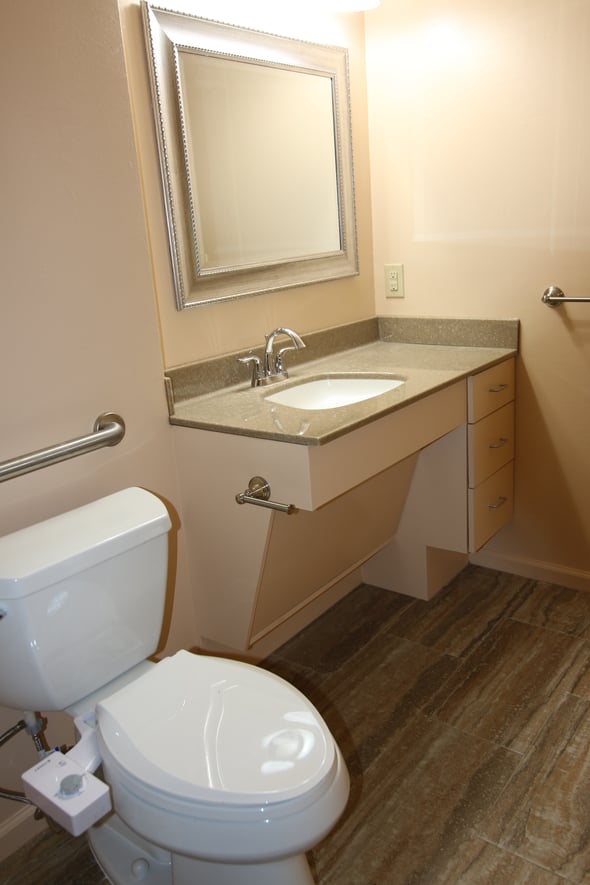

1. Vanity Sink Accessibility
Wheelchair Accessible bathrooms today contain stylish ADA vanities set at a universal height of 34 inches with clear knee spaces. Plan on 27 inches of vertical clearance for a wheelchair. The sink faucets must be easily controlled by either wrist handles or levers. The faucets can be fitted on the side of the sink to make them easier to reach. Or install infra-red faucets that detect motion. Hang the mirror low enough for a seated person to see themselves, and tip the top of the mirror out. Bathroom vanities with universal height cabinet tops and open knee spaces are taking over the marketplace. These new residential vanities do not need to look institutional. They can be designed like any other piece of fine furniture. Scalding must be guarded against by using either insulating pipe wrap or a removable panel for the plumbing.
2. Toilet Accessibility
Toilets are available in comfort heights eliminating the deep knee bend needed for seating. Grab bars should be installed on at least both sides of the toilet. Ideally, the toilet should be positioned between two support bars 36 inches apart. A toilet seat 17 inches off the floor is a more comfortable height for everyone. Creating a toilet within an open area and not a closet is much more accessible. Elevated or special toilet seats are available with a heat feature and some have the ability to self close or have a night light. A more expensive bidet/toilet is available but an add on bidet attachment to a regular toilet can be handy.
3. Bathing Facilities
Curbless roll in showers that are 5 feet wide and 3 feet deep having a 36" clear entrance are advised for everyone. The shower should contain at least a shower wand on a sliding bar for varying heights of use along with a regular shower head and control if desired. Installing fixtures with a scald guard or lowering the temperature at the water heater is a must to prevent burns. Folding seats in the shower are useful if caretakers are ever involved and they are much safer than a free standing shower seat which can fall over. Grab bars around the bath and especially in the shower should be used while non slip floor covering should always be considered. Walk in tubs are also a consideration but some people get chilled while the tub is draining. Install the slider bar for the hand held shower hose and head 4 feet off the floor so that the head can slide up to 6 feet high. Always use a shower valve that is thermostatically controlled and pressure-balanced to prevent scalds. If you desire a full body wash, you can include a regular shower head as well.
4. Safety and Accessibility
Always choose fixtures and fittings that are easy to control with a single hand motion or a closed fist. Motion controlled sensor fixtures are also a possibility when specifying finishes. Provide easily accessible storage compartments with pull out shelving eliminating architectural barriers by not using doors on the cabinetry. Always consider the individual needs of the occupant and find the best placement of any reachable items within their reach distance of 24". Fully consider where the best access is for all accessories such as robe hooks, towel bars, paper dispensers, soap dishes, toothbrush holders, shower shelves. The distances and clearances required will be dictated by the user and not by an accepted general outline. With falls in the wet area of the bathroom being such a great concern, a non slip tile floor should be installed without placing loose rugs in the general area. All doors should have levers instead of door knobs. The Americans with Disabilities Act requires a 5-foot turning radius for a wheelchair. But if space is tight, remodelers may be able to make do with less. "(The 5-foor turning radius) may not always be needed, especially with an electric chair, which will easily turn in a tighter space.
5. Lighting
Natural lighting is always better for anyone using the bath. Adequate task lighting in the shower, dressing area, and vanity vicinity should be installed. Lowered switches at around 48" above the floor in reaching distance should control all the lighting. You can install switches with a push button or large toggle that doesn't require a pinching motion to turn on and off. Outlets that are ground protected should be installed at 18" above the floor.

Aging in place home modifications are available through T-Square Company. Each design/build situation will be customized to fit your personal needs. Call 512-444-0097 today to begin the accessible second chapter of your life while remaining safe and secure in your existing home. CAPS 1636580
Tags:
ADA accessible,
ADA bathroom cabinets accessible routes,
aging in place home modifications,
wheelchair accessible remodeling,
handicap home modifications,
CAPS certified remodeling in Austin,
ADA compliance,
disability bathroom remodels,
accessibility home remodeling in Austin,
accessible home remodeling,
Universal Design,,
Austin bath remodeling,
Austin bathroom remodeling,
disability home remodeling in Austin,
disability bathroom remodeling in Austin,
aging in place design,,
disability home modifications in Austin,
Austin elder construction,
remodel bathroom for handicap Austin Texas,
handicap home modifications for disabled,
handicap accessibility,
handicap remodeling contractors,
bathroom modifications for disabled,
disability home modifications,
home improvements Austin,,
bathroom accessibility remodels in Austin,
accessibility remodelers in Austin,
ADA remodeling Austin, Texas,
ADA bathroom Austin, Texas,
wheelchair accessible showers in Austin,,
roll in showers,
accessibility designs Austin Texas,
disability access bathrooms Austin,
certified aging in place consultant in Austin,
bathroom modifications for disabled in Austin, TX,
aging in place design in Austin,
senior aging in place services,
home remodeling for disabled in Austin Texas,
disability contractor in Austin,
special needs contractor in Austin,
disability and special needs contractor Austin,
bathrooms with disability access in Austin, Texas,
accessible bathroom design specifications,
home accessibility,
accessible housing,
handicap accessible housing,
handicap accessible house plans,
accessible homes in austin,
Austin home remodeling for disabled,
accessibility home modifications,
accessible home modifications,
wheelchair accessible bathroom,
handicap bathroom design,
handicap bathroom requirements,
handicap bathroom accessories
Designing for specific physical conditions during a handicap retrofit will lessen the impact of say arthritis, restricted mobility, or loss of vision by using combinations of products, concepts, and techniques available today. Working as a team, a trained CAPS specialist along with any family caretakers or therapists is able to identify the day to day problems weighing on those with health limitations. If you are considering an aging in place remodel for your home don't just contact any local remodeler in your area and expect a satisfactory accessible home modification. A professional design/build accessibility project can only be created for your specific needs by a qualified home remodeler having a nationally accepted CAPS (Certified Aging In Place Specialist) certification. This credential is backed by the NAHB. Only a CAPS home remodeler possesses the specific knowledge that will insure a successful outcome for your accessibility or aging in place project and what's more, keep you in your home longer.

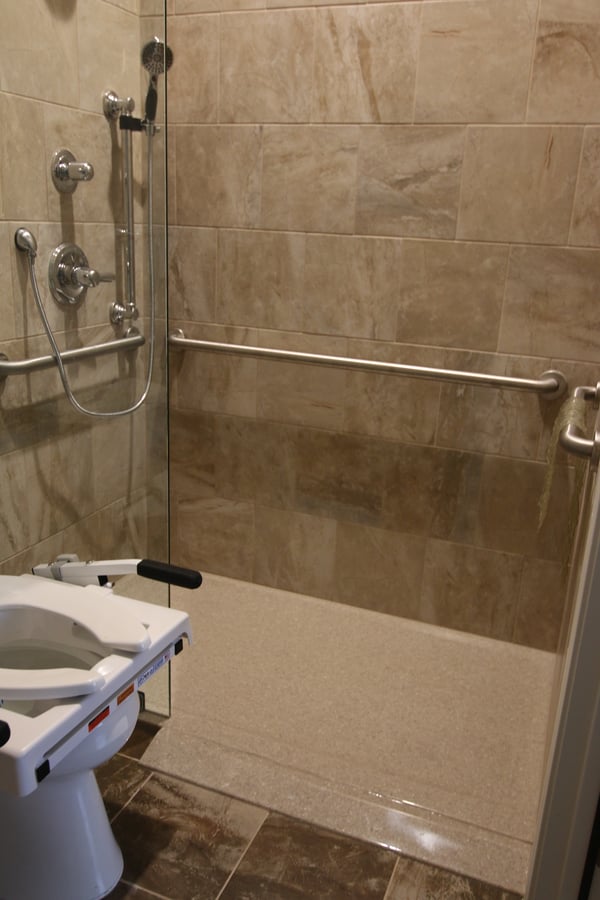

Disability is a complex phenomenon representing an interaction between one's physical impairments, the activities they need to perform, and the architectural barriers within the space in which this situation occurs. The terminology and jargon used for disabilities evolves regularly whereas, "handicapped" is no longer acceptable. It is no longer merely a description of intellectual or physical impairments. Each individual with similar impairments describes his or her limitations differently. The blind don't experience their world the same as a person with deafness and so on. Physically challenged has become the more socially accepted description of a person with an impairment.
Physical limitations affect many more people than the daily users of walkers and wheelchairs. Many members of our life experienced or elder society have significant problems in dealing with their home environment. Today's conventional building standards conflict with most people's accessibility when you consider our created architectural barriers concerning cabinetry and door opening widths, individual strength, range of motion, movement, manual dexterity, balance, and coordination . Once the demands of our built environment exceed their capacities we become excluded from a room or even the entire home. This has brought about the realization that handicap bathrooms are needed. The building world must work in unison to be sure the entire living environment meets basic needs in addition to affordability and structural integrity for the consumer and home owner. This includes both the home and the components within the home being accessible to all inhabitants. Privacy, sense of belonging, sense of control, and the sense of safety and security make up the quality of life for any home and should be considered for any accessibility design.
Wheelchair accessible bathrooms today contain stylish vanities set at a universal height of 34 inches with clear knee spaces. Plan on 27 inches of vertical clearance for a wheelchair. The sink faucets must be easily controlled by either wrist handles or levers. The faucets can be fitted on the side of the sink to make them easier to reach. Or install infra-red faucets that detect motion. Hang the mirror low enough for a seated person to see themselves, and tip the top of the mirror out. bathroom vanities with universal height cabinet tops and open knee spaces are taking over the marketplace. These new residential vanities do not need to look institutional even though they are wheelchair accessible. They can be designed like any other piece of fine furniture. Scalding must be guarded against by using either insulating pipe wrap or a removable panel for the plumbing.
The threshold is the most dangerous component for any ADA compatible shower. Not only is it impossible to overcome in a wheelchair but it isn't safe for those who are vision impaired or those with mobility issues. Curbless roll in showers that are 5 feet wide and 3 feet deep having a 36" clear entrance are advised for everyone. Low threshold shower bases with add on ramps can solve the shower entry problem when the floor cannot be lowered to form a true contoured roll in slope. The accessible shower should contain at least a shower wand on a sliding bar for varying heights of use along with a regular shower head and control if desired. Installing fixtures with a scald guard or lowering the temperature at the water heater is a must to prevent burns. Install the slider bar for the hand held shower hose and head 4 feet off the floor so that the head can slide up to 6 feet high. Always use a shower valve installed below or at 48" from the finished floor that is thermostatically controlled and pressure-balanced to prevent scalds. If you desire a full body wash, you can include a regular shower head as well. Always choose fixtures and fittings that are easy to control with a single hand motion or a closed fist. Motion controlled sensor fixtures are also a possibility when specifying fixtures and finishes. Built-in shower seats provide comfort and safety but can sometimes get in the way of accessibility. Folding seats are an option in the shower and are useful if caretakers are ever involved or a shower chair is ever required. These seats are much safer than a free standing shower seat which can collapse and cause a fall. Recessed shampoo niches located 48" above the floor help keep shower floors or seats free of trip hazards. Grab bars around the bath and especially on each wall in the shower installed at 34-36" above the floor should be used. All grab bars must be secured into either adequate wood blocking or existing wall studs so they can hold at least 250 pounds of downward force. Non slip floor covering should always be considered with a 0.5 friction coefficient rating. Enclosures can vary by the accessibility needed by all and can be everything from an out-swinging frame-less door to just a simple glass splash panel or even a curtain on a curved rod. Walk in tubs are also a consideration but some people get chilled while the tub is draining.

Austin handicap remodeling, aging in place home modifications, and ADA Accessible kitchens are available through T-Square Company. Each design/build handicap accessibility situation will be customized to fit your personal needs. Call 512-444-0097 today to begin the accessible second chapter of your life while remaining safe and secure in your existing home. CAPS 1636580
Tags:
Austin,
residential construction contractor,
kitchen cabinetry,
commercial cabinetry,
ADA accessible,
accessible routes,
aging in place home modifications,
aging in place,
bathroom remodeling,
wheelchair accessible remodeling,
wheelchair accessible baths and kitchens,
handicap home modifications,
fine bathroom upgrades,
ADA remodeling,
home remodeling,
CAPS certified remodeling in Austin,
disability bathroom remodels,
handicap accessible bathrooms,
accessibility home remodeling in Austin,
CAPS professional in Austin,
accessible home remodeling,
Austin bathroom remodeling,
disability bathroom remodeling in Austin,
aging in place specialist,
aging in place services,
aging in place design,,
elder construction,
handicap remodeling contractors in Austin,
disability home modifications in Austin,
Austin elder construction,
bathroom remodeling contractor Austin Texas,
remodel bathroom for handicap Austin Texas,
handicap home modifications for disabled,
handicap accessibility,
bathroom modifications for disabled,
bathroom accessibility remodels in Austin,
accessibility remodelers in Austin,
home remodeling Austin, Texas,
ADA bathroom Austin, Texas,
accessibility designs Austin Texas,
disability access bathrooms Austin,
wheelchair accessible home remodeling in Austin,
home remodeling for seniors Austin,
disability contractor in Austin,
bathrooms with disability access in Austin, Texas,
handicap remodeling,
handicap accessible home modifications,
handicap accessible bathroom remodel,
handicap access bathroom remodel,
handicap accessible bathroom shower,
roll in shower design for wheelchair access,
home modifications for Austin veterans,
barrier free showers in Austin,
wheelchair accessible shower stalls,
disabled bathroom remodel,
accessible bathroom remodel,
home access,
accessible homes,
Austin bathtub to shower conversions,
bathroom remodeling contractors Austin, TX,
bathroom remodel contractor,
Austin home remodeling for disabled,
wheelchair accessible bathroom
Many people find themselves needing wheelchair accessible housing for themselves or family members. There are approximately 30 million Americans using wheelchairs and the number of people who need accessible homes in Austin will continue to increase as disabled and aging people are finding more ways to remain living in their homes. One important way to increase independent living is making a home accessible to an individuals personal needs. Home modifications making homes wheelchair accessible can increase safety, accessibility, and independence for people who want to live independently.
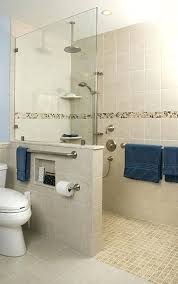
More and more people are finding themselves needing disability bathroom remodels in Austin to modify the existing architecture of their homes due to the use of a wheelchair or walker while preparing to remain in their homes as they age in place. There are currently over 30 million Americans using wheelchairs and those numbers continue to increase as a large population of people with age related challenges look for ways to live independently in their homes. Physical limitations affect many more people than the daily users of walkers and wheelchairs. Many members of our life experienced or elder society have significant problems in dealing with their home environment. Today's conventional building standards conflict with most people's accessibility when you consider our created architectural barriers concerning cabinetry and door opening widths, individual strength, range of motion, movement, manual dexterity, balance, and coordination. Once the demands of our built environment exceed their capacities we become excluded from a room or even the entire home. The building world must work in unison to be sure the entire living environment meets basic needs in addition to affordability and structural integrity for the consumer and home owner. This includes both the home and the components within the home being accessible to all inhabitants. Privacy, sense of belonging, sense of control, and the sense of safety and security make up the quality of life for any home and should be considered for any design increasing home accessibility.

T-Square Company offers Wheelchair Accessible Housing
The Top Five Items To Include In An Accessible Bathroom Design
1. Vanity Sink Accessibility
Accessible bathrooms today contain stylish vanities set at a universal height of 34 inches with clear knee spaces. The sink faucets must be easily controlled by either wrist handles or levers. Bathroom vanities with universal height cabinet tops and open knee spaces are taking over the marketplace. These new residential ADA vanities do not need to look institutional. They can be designed like any other piece of fine furniture. Scalding must be guarded against by using either insulating pipe wrap or a removable panel for the plumbing.
2. Toilet Accessibility
Toilets are available in comfort heights eliminating the deep knee bend needed for seating. Grab bars should be installed on at least both sides of the toilet. Creating a toilet within an open area and not a closet is much more accessible. Toilet seats are available with a heat feature and some have the ability to self close or have a night light.
3. Bathing Facilities
Curbless roll in showers with a 36" clear entrance are advised for everyone. The shower should contain at least a shower wand on a sliding bar for varying heights of use along with a regular shower head and control if desired. Installing fixtures with a scald guard or lowering the temperature at the water heater is a must to prevent burns. Folding seats in the shower are useful if caretakers are ever involved. Grab bars around the bath and especially in the shower should be used while non slip floor covering should always be considered. Walk in tubs are also a consideration but some people get chilled while the tub is draining.
4. Safety and Accessibility
Always choose fixtures and fittings that are easy to control with a single hand motion or a closed fist. Motion controlled sensor fixtures are also a possibility when specifying finishes. Provide easily accessible storage compartments with pull out shelving eliminating architectural barriers by not using doors on the cabinetry. Always consider the individual needs of the occupant and find the best placement of any reachable items within their reach distance of 24". Fully consider where the best access is for all accessories such as robe hooks, towel bars, paper dispensers, soap dishes, toothbrush holders, shower shelves. The distances and clearances required will be dictated by the user and not by an accepted general outline. With falls in the wet area of the bathroom being such a great concern, a non slip tile floor should be installed without placing loose rugs in the general area.
5. Lighting
Natural lighting is always better for anyone using the bath. Adequate task lighting in the shower, dressing area, and vanity vicinity should be installed. Lowered switches at around 48" above the floor in reaching distance should control all the lighting. Outlets that are ground protected should be installed at 18" above the floor.

There are really three categories of aging in place customers. Those who are simply and wisely planning ahead for their futures to remain in their present homes. The second category concerns those people who know they have a chronic medical disorder and need to prepare in advance for accessibility issues which will come as a result of their disease. People with diseases that are constantly causing increased physical or mental changes to their being are a good representative of this second group. The third group involves those people who either have had a chronic problem that has progressed severely altering their mobility or those who have sustained a life altering tragedy such as being involved in an accident. All of these groups will drive the future metamorphosis of existing inaccessible dwellings.
Accessible wheelchair designs in Austin are available through T-Square Company. Each design/build situation will be customized to fit your personal needs. Call 512-444-0097 today to begin your accessible second chapter in your life while remaining safe and secure in your existing home. CAPS 1636580

Tags:
wheelchair accessible baths,
accessibility home remodeling in Austin,
accessible home remodeling,
CAPS remodeling techniques,
disability home remodeling in Austin,
bathroom modifications for elderly,
aging in place services,
Austin elder construction,
bathroom remodeling contractor Austin Texas,
remodel bathroom for handicap Austin Texas,
handicap home modifications for disabled,
handicap remodeling contractors,
bathroom modifications for disabled,
ADA vanities,
home modifications Austin, Texas,
ADA remodeling Austin, Texas,
ADA bathroom Austin, Texas,
roll in showers,
handicap bathrooms,
disability access bathrooms Austin,
disability remodeling in Austin,
Austin Handicap Remodeling,
Austin senior living solutions,
Austin ADA vanity,
certified aging in place consultant in Austin,
bathroom modifications for disabled in Austin, TX,
aging in place specialist in Austin,
aging in place design in Austin,
age in place home design,
home modifications for disabled children,
home modifications for children with disabilities,
why is aging in place important,
what does it mean to age in place,
universal designbuilding for the future,
home remodeling contractor near Austin, Texas,
Austin remodeling,
aging in place home remodeling,
home remodeling for disabled,
remodeling companies in Austin TX,
home accessibility help in Austin,
home remodeling for disabled in Austin Texas,
wheelchair accessible home remodeling in Austin,
home accessibility,
wheelchair accessible housing,
accessible housing,
handicap accessible housing































